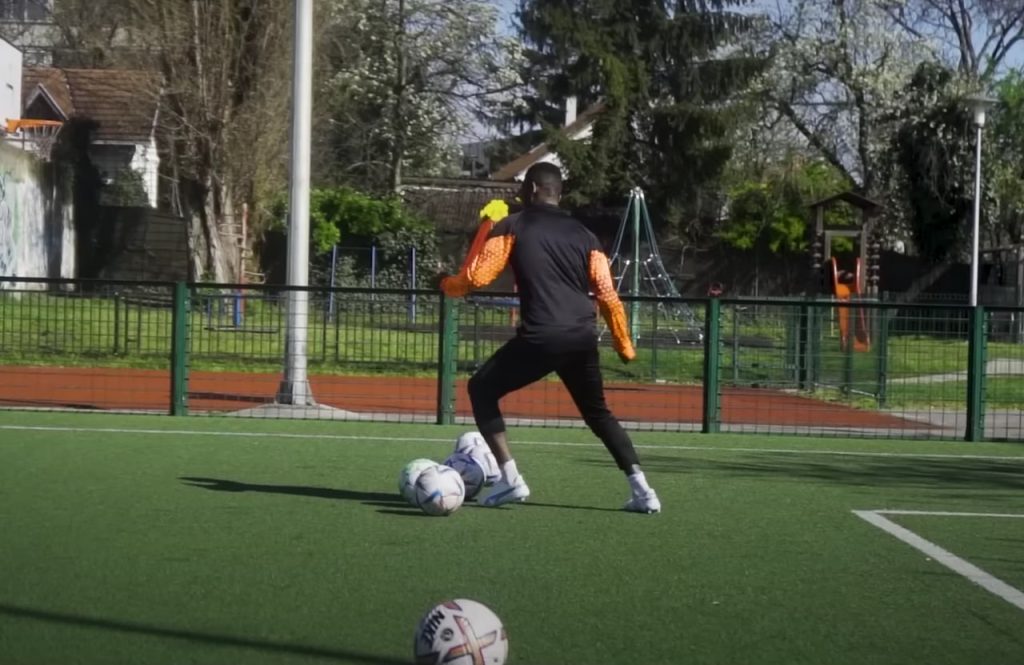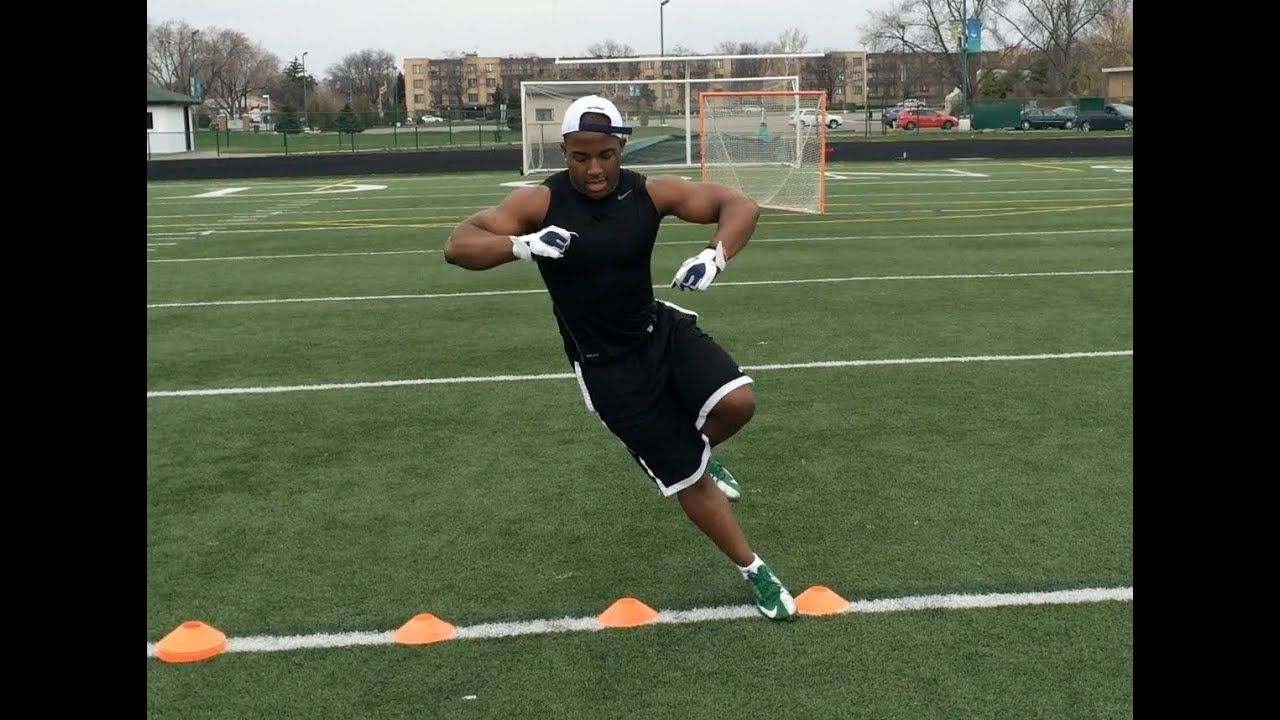Hey there, football enthusiasts! If you're aiming to boost your speed on the field while keeping injuries at bay, you're in the right place. Speed is a game-changer, but there’s more to it than just running fast. In this post, we’ll delve into effective tips to help you enhance your speed and ensure you play safe. Let’s kick things off!
Understanding the Importance of Speed in Football

Speed in football is not just about sprinting; it's a multi-faceted skill that can significantly impact your performance and your team's success. Whether you're a striker trying to outrun defenders or a defender aiming to catch up to an attacker, speed is a *valuable asset. Here’s why:
- Improved Performance: Speed enables players to make quick moves, dodge opponents, and create scoring opportunities. It can often be the difference between winning and losing a match.
- Enhanced Agility: Alongside speed, agility is crucial. Quick changes in direction or sudden bursts of speed can help you stay one step ahead of your rivals.
- Better Positioning: Faster players can position themselves strategically during plays, allowing them to intercept passes or support teammates more efficiently.
- Psychological Edge: Speed can instill fear in opponents. When they know you can outpace them, you gain a psychological advantage, which is invaluable in high-pressure situations.
However, it's essential to frame speed within the context of the game. It's not merely about raw speed; it should be coupled with:
| Factor | Description |
|---|---|
| Technique | Proper running form helps maximize your speed and efficiency. |
| Endurance | Maintaining speed throughout the game is crucial—training your endurance can help. |
| Strength | Building leg strength helps you to push off harder and run faster. |
| Coordination | Good coordination ensures that your arms and legs work harmoniously while running. |
To really become a standout player, you'll need to blend these elements with your natural speed. If you work on enhancing your technical skills and understand your body's mechanics, you'll see an improvement not only in your speed but in your overall gameplay.
Finally, remember that speed can be trained. With the right drills, strategies, and mindset, you can significantly enhance your speed and agility while minimizing the risk of injuries. So, let’s dive into the essential tips that can help you achieve these goals.
Also Read This: Is It Legal to Watch British TV Series on Dailymotion
3. Proper Warm-Up Techniques to Enhance Performance

Before you hit the field and give it your all in a football game, it's crucial to prepare your body with the right warm-up techniques. Think of your warm-up as the bridge between your everyday life and peak athletic performance. A proper warm-up not only helps boost your speed but also plays a significant role in preventing injuries. Let’s dive into some effective strategies!
Start with Dynamic Stretching: Unlike static stretching, which you should save for after your game, dynamic stretching gets your muscles moving in a controlled way. These movements gradually increase your heart rate and improve blood flow to your muscles. Here are some dynamic stretches you can include:
- Leg Swings: Forward and sideways swings to loosen up your hips and legs.
- High Knees: Running in place while driving your knees up to your chest.
- Butt Kicks: Jogging while trying to kick your heels to your glutes.
- Lateral Lunges: Stepping side-to-side to stretch and strengthen your groin and hips.
Incorporate Movement Drills: After getting your blood pumping, it's time to practice movements you'll actually use during the game. Incorporating drills can enhance your agility and speed. Here are a couple of drills to consider:
- A-Skip: This drill helps with running form and coordination. Alternate lifting your knees while skipping forward.
- Backpedaling: Improve your reaction time and speed by backpedaling for a short distance, focusing on quick, controlled movements.
Progress to Sport-Specific Exercises: Now that you're feeling warm, include drills that mimic in-game scenarios. Sprinting short distances, practicing your first steps out of a start position, and working on quick cuts can be incredibly beneficial. These exercises get your body ready for the intensity of the game, making it easier to spring into action!
Think About Your Mental Game: A good warm-up isn’t just about your muscles; it's mental too. Use this time to focus. Visualize your plays, strategize with teammates, and get in the zone. This will not only improve your performance but help reduce anxiety prior to the game.
In summary, a good warm-up prepares both your body and mind for the challenges ahead. Remember to dedicate at least 15-20 minutes to warm up properly. Your body will thank you for it by helping you run faster and play better while keeping injuries at bay!
Also Read This: Is There a Dailymotion App for Amazon Fire Stick? How to Stream Videos on Your Fire Stick
4. Strength Training Exercises for Improved Speed
If you're serious about boosting your speed on the football field, incorporating strength training exercises into your routine is a game changer. Building muscle strength not only enhances speed but also fortifies your body against injuries. Let’s break down some exercises that can help you become a faster, more agile player.
Focus on Lower Body Strength: Most of your speed in football comes from your legs, so it's essential to target your lower body. Here are some of the best exercises:
- Squats: A fundamental exercise for leg strength, squats develop your quads, hamstrings, and glutes. Try different variations like front squats or jump squats to keep things fresh.
- Deadlifts: This exercise strengthens both your upper and lower body, focusing on the hamstrings and back. Strengthening these areas can significantly improve your sprinting power.
- Lunges: Great for targeting quadriceps and glutes, lunges also improve balance and coordination. Incorporate variations such as reverse lunges or lateral lunges.
Include Plyometric Workouts: Plyometrics are explosive movements that can significantly improve your speed. Here are a couple of plyometric exercises to try:
- Box Jumps: Jumping onto a sturdy box or platform enhances leg power and reactive strength.
- Burpees: A full body exercise that, when done quickly, can also serve as a cardio workout while building strength.
Don’t Forget Your Core: A strong core is fundamental for powerful movements. Incorporate exercises like planks, Russian twists, and medicine ball throws into your routine to ensure your body is stable and effective in its movements.
Train Regularly but Smart*: Your muscles grow during recovery, not just during workouts. Be sure to allow for proper rest days and listen to your body. If you're feeling fatigued or sore, give yourself a break to avoid burnout or injury.
In conclusion, strength training is an essential component for anyone looking to enhance their speed in football. By focusing on the right exercises and maintaining a balanced program, you'll find yourself running faster, while also staying in shape and preventing injuries along the way. The key is consistency and dedication!
Also Read This: Uploading Videos to Dailymotion on the Website in 2018
5. Footwear Selection: Choosing the Right Cleats
When it comes to running faster in football, one of the most crucial factors is your footwear. Choosing the right cleats can make a world of difference, not just in your speed but also in how well you protect your feet and avoid injuries. Let's dive into some effective tips on selecting the best cleats for your game.
Understand the Different Types of Cleats: Football cleats come in various styles designed for different surfaces and play styles. Here are the main types:
- High-top Cleats: These provide ankle support which can be beneficial for players who need extra stability.
- Mid-top Cleats: A balance between agility and support, these are versatile for various playing styles.
- Low-top Cleats: Ideal for speed, allowing for greater ankle mobility. However, they offer less support.
Consider Your Playing Surface: The type of ground you play on greatly influences your choice of cleats:
- Firm Ground (FG): Ideal for natural grass fields, these cleats feature conical or bladed studs for optimal traction.
- Artificial Ground (AG): Designed for synthetic fields, these usually have shorter, more numerous studs to prevent injuries.
- Soft Ground (SG): Perfect for muddy or soft fields, these cleats have longer studs for digging into the ground.
Get the Right Fit: Make sure your cleats fit snugly but aren't too tight. A general rule is to have about a thumb's width of space at the toe. Ill-fitting shoes can lead to blisters, calluses, and more serious injuries.
The Right Material Matters: Cleats come in various materials, from leather to synthetic fabrics. Leather offers great durability and a better fit over time, while synthetic options may be lighter and more breathable. Choose the material that best fits your comfort level and budget.
Test Them Out: Ideally, you should try on cleats online or in-store. Walk, jog, and even perform lateral movements to simulate on-field actions. Pay attention to how they feel during these activities and whether they support your feet properly.
By focusing on the right footwear, you can enhance your performance and reduce your risk of injuries while you aim to improve your speed on the field.
Also Read This: Football Basics for Beginners: Learn with Dailymotion Tutorials
6. Incorporating Speed Drills into Your Routine
Now that you've got the right cleats on your feet, let's talk about how to boost that speed with effective speed drills! Integrating specific drills into your training routine can significantly enhance your acceleration, top speed, and overall agility.
Warm-Up First: Before diving into drills, always start with a dynamic warm-up. This can include exercises like:
- Leg swings
- Arm circles
- High knees
- Butt kicks
This prepares your muscles and joints, ensuring they're ready for the high-intensity workout ahead.
Speed Ladder Drills: The agility ladder is a fantastic tool for improving foot speed and coordination. Here are a few effective drills to incorporate:
| Drill | Description |
|---|---|
| Two-Foot In & Out | Step with both feet into each square, then out. Focus on quick, precise steps. |
| Single-Leg Hops | Hop in and out of each square on one foot to build balance and strength. |
| In & Out Shuffle | Face sideways and step in and out of the ladder, pushing off on the outside foot. |
Sprint Intervals: Incorporating sprint intervals into your workout can also increase your speed. Try this method:
- Sprint at maximum effort for 20-30 seconds.
- Follow up with a 1-2 minute jog or walk to recover.
- Repeat for 5-10 rounds.
Resisted Sprints: Adding resistance can enhance your explosive strength. You can use a sled, parachute, or resistance bands to challenge yourself while sprinting.
Consistency is Key: Like any skill, the more you practice speed drills, the better you'll become. Aim to incorporate speed drills into your training routine at least twice a week for maximum improvements.
So lace up those cleats, hit the field, and watch as your speed and agility soar! Remember, consistency and proper technique will lead you to become a faster, more efficient football player.
Also Read This: How to Do Manicure and Pedicure at Home on Dailymotion: A Complete Guide for Gorgeous Nails
7. Maintaining Proper Running Form to Avoid Injuries
When it comes to running faster in football, maintaining proper running form is crucial—not just for speed, but also for preventing injuries. It's easy to get caught up in the excitement of the game, but if your technique is off, you might find yourself sidelined. So, let's break down some key aspects of proper running form.
Body Alignment: Start with a straight body posture. Your head should be up, looking ahead, with your shoulders relaxed. An upright torso helps maintain balance and maximize your speed. Try to keep your hips aligned with your knees and feet, avoiding any unnecessary lean that could throw you off balance.
Arm Movement: Don’t underestimate the power of your arms! They play a vital role in your running speed. Keep your elbows bent at about 90 degrees, swinging your arms back and forth in a fluid motion. Avoid crossing your arms over your body, as this can cause you to lose speed and stability.
Foot Placement: Aim for a mid-foot strike rather than landing heavily on your heels or only on your toes. A mid-foot strike ensures better shock absorption and reduces the impact on your joints. Ensure your feet are landing beneath your hips, which helps to maintain your momentum.
Stride Length: While it might be tempting to overextend your stride to cover more ground, this can lead to injuries. Focus instead on a quick turnover with shorter strides. This allows for better control and a more powerful push-off. Practice drills that encourage a quicker foot turnover to build this habit.
Breathing Technique: Don’t forget about your breathing! Proper breathing can enhance your endurance and keep you focused. Aim for deep belly breaths, inhaling through your nose and exhaling through your mouth. This can help to keep your heart rate steady and your energy levels up while you're making those fast runs on the field.
Lastly, always pay attention to your body. If you start feeling discomfort or pain, assess your form and make necessary adjustments. Running is as much about technique as it is about speed, and in football, a minor tweak to your form could prevent a major injury.
Also Read This: How to Download Dailymotion Videos from SaveFrom.net: A Simple Tutorial
8. The Role of Conditioning in Speed Enhancement
Conditioning is a cornerstone of athletic performance, especially in sports like football that demand endurance, speed, and agility. When you're conditioned properly, your body efficiently delivers energy, allowing for faster runs and quicker recovery. Let's dive into how conditioning contributes to speed enhancement and overall performance.
Cardiovascular Conditioning: A strong cardiovascular system boosts your endurance and stamina, which is essential during long matches. Incorporate interval training into your workouts. For example, alternating between sprinting and jogging not only improves your speed but also mimics the stop-and-go nature of football.
Strength Training: Believe it or not, lifting weights can make you a faster football player. Target muscle groups relevant to running: quadriceps, hamstrings, calves, and glutes. Building strength in these areas can improve your power during sprints. Exercises like squats, lunges, and deadlifts can be particularly effective.
Agility Drills: Speed isn't just about straight-line running; it’s also about how quickly you can change direction. Incorporate agility drills like shuttle runs or ladder drills into your routine. These drills enhance your foot speed and overall coordination, making it easier to outmaneuver opponents on the field.
Flexibility Training: Don't overlook the importance of flexibility! Regular stretching not only aids recovery but also improves your range of motion. Consider yoga or dynamic stretching routines to enhance your flexibility, which can lead to more explosive runs while reducing the risk of muscle strains.
Recovery: Finally, effective conditioning isn’t just about training hard; it’s about recovering well. Adequate sleep, hydration, and nutrition are essential components of a successful conditioning program. Listen to your body and take rest days when needed to prevent overtraining.
In conclusion, conditioning plays a vital role in enhancing your speed in football. By working on your cardio, strength, agility, and recovery, you’ll see significant improvements in your ability to run faster while staying injury-free. Now, lace up those cleats and hit the practice field!
Also Read This: Understanding Dailymotion Video Upload Limits
9. Nutrition and Hydration Tips for Optimal Performance
When it comes to running faster in football, what you put into your body can make all the difference. Proper nutrition and hydration are crucial not just for performance on the pitch but also for recovery and injury prevention. So, let’s dive into some effective tips!
Hydration is Key! Staying hydrated keeps your body functioning optimally. Dehydration can significantly reduce your performance and increase the risk of injury. Aim to:
- Drink at least 8-10 glasses of water daily, adjusting for activity level.
- Consume electrolytes, especially in hot weather or during intense training sessions.
- Start hydrating well before game day; don't wait until you feel thirsty!
Now onto nutrition—what you eat plays a pivotal role in how you perform:
- Carbohydrates: These are your body's primary energy source. Include whole grains, fruits, and vegetables in your diet to fuel your runs.
- Protein: Important for muscle repair, aim for lean proteins like chicken, fish, legumes, and dairy.
- Fats: Healthy fats, such as avocados and nuts, can provide a great energy source. Just be sure to keep them in moderation.
Timing your meals can also impact your performance. Try to:
- Eat a balanced meal with carbs and protein about 3-4 hours before your game.
- Have a light snack 30-60 minutes prior—something easily digestible, like a banana or a piece of toast.
Lastly, recovery is just as important as fueling for performance:
- Replenish lost fluids and nutrients within 30 minutes of the game or practice.
- Consider snacks rich in protein and carbs post-game to promote muscle recovery.
Remember, all athletes are different, so listen to what works for your body. Experiment with your nutrition and hydration strategies to see which combination helps you perform at your best!
Also Read This: DIY Nail Art Techniques at Home with Dailymotion Video Guides
10. Listening to Your Body: Recognizing Signs of Overtraining
As you strive to improve your speed and overall performance in football, it's essential to also focus on how your body is reacting to the demands you’re placing on it. Overtraining can lead to injuries, burnout, and decreased performance, so being mindful is crucial.
Understanding the Signs: Recognizing when you're pushing too hard is the first step in preventing overtraining. Here are some common signs to watch out for:
- Chronic Fatigue: If you feel persistently tired, it might be more than just a long week of practice.
- Decreased Performance: Have your times gotten worse even with more effort? This could signal overtraining.
- Frequent Injuries: If you're picking up minor injuries that don’t seem to heal, take a red flag.
- Mood Changes: Irritability, anxiety, or depression can be signs that your body is overloaded.
When you notice these signs, it's time to take a step back and assess:
- Consider incorporating rest days into your training routine.
- Evaluate your training intensity and volume; it might be time for a downward adjustment.
- Engage in lighter forms of cross-training like swimming or cycling to maintain fitness levels without overexerting yourself.
Prioritizing Recovery: Remember, rest is just as important as training. Make sure to get adequate sleep, which is crucial for muscle recovery and overall health. Consider practices like:
- Incorporating stretching and mobility work into your routine.
- Using techniques such as foam rolling to alleviate muscle tightness.
- Listening to your body's signals and being mindful of when to take a break.
By tuning into your body and acknowledging its needs, you’ll set yourself up for a more sustainable and enjoyable journey in football. Training smart not only improves performance but also sets the stage for a long, fulfilling athletic career.
Conclusion: Putting It All Together for Success on the Field
To maximize your performance and speed on the football field while minimizing the risk of injuries, it's crucial to integrate the various tips and strategies discussed throughout this post. Here are some key takeaways to implement:
- Incorporate Speed Drills: Engage in specific speed drills such as sprinting and agility exercises.
- Focus on Technique: Maintain proper running posture and foot placement to enhance efficiency.
- Build Strength: Include strength training exercises targeting your legs and core to support faster running.
- Prioritize Flexibility: Regularly stretch and use mobility exercises to keep your muscles limber.
- Listen to Your Body: Pay attention to any warning signs of injury and allow ample recovery time.
Moreover, consider creating a personalized training program that balances speed work with strength and recovery. By following a consistent routine and incorporating these components, you can effectively improve your speed and on-field performance.
Finally, remember that success in football isn't solely about running faster; it's about playing smarter and healthier. By putting all these tips into practice, you're not only enhancing your speed but also setting yourself up for long-term success on the football field.
 admin
admin








